|
 |
keeping you - |
AWARE OF THE PAST
ABREAST OF THE PRESENT
ALERT ABOUT THE FUTURE |
|
 |
| |
| Mohen-jo-Daro, Larkana District, Pakistan |
| |
|
| |
|
Ruins of the city of Mohen jo Daro show that it was one of the earliest examples of a planned city. The streets were laid out according to a grid and were well drained. It was an important center of the Indus civilization, which flourished in SINDH about 15000-11000 BC till 1700 BC.

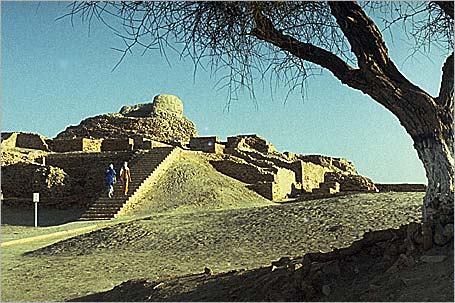
|
|
|
| |
|
The Buddhist Stupa (circa 200 A.D.)
This view shows the high western mound made up of a massive mud brick platform and brick houses of the Harappan period ( 2600 to 1900 B. C.). On top of the Harappan structures is a Buddhist period stupa made of mud brick that dates to the first century A.D.

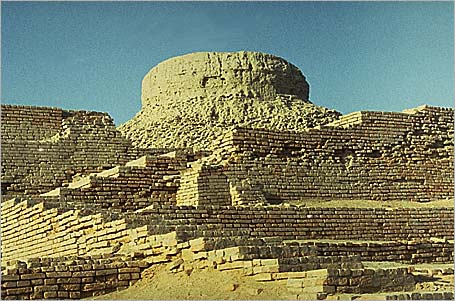
|
|
|
| |
|
View from Stupa towards Great Bath

A general view of the "Great Bath" and adjoining rooms. In the background is a massive brick structure referred to as the "Granary". Built on top of a tapered brick platform this building had a solid brick foundation that extended for 50 meters east west and 27 meters north south. The foundation was divided into 27 square and rectangular blocks by narrow passageways, two running east west and 8 running north south. Some of these blocks had square sockets for holding wooden beams or pillars and the entire super structure was thought to have been made of timbers.
Now that the entire structure has been excavated it is impossible to determine what types of artifacts were found in the passageways or nearby rooms, but the lack of charred grain or even storage containers, and the absence of sealings from bundles of goods all raise doubts as to the identification of this structure as a granary or a storehouse. A more appropriate name for this structure would be the "great hall" since it was clearly a large and spacious building with wooden columns and many rooms.
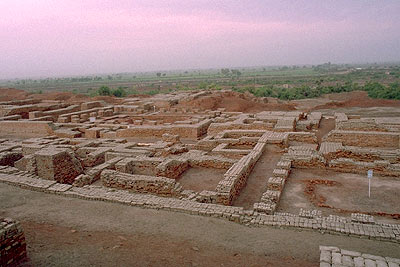
|
|
|
| |
|
"Great Bath," Mohenjo-daro
The "great bath" is without doubt the earliest public water tank in the ancient world. The tank itself measures approximately 12 meters north-south and 7 meters wide, with a maximum depth of 2.4 meters. Two wide staircases lead down into the tank from the north and south and small sockets at the edges of the stairs are thought to have held wooden planks or treads. At the foot of the stairs is a small ledge with a brick edging that extends the entire width of the pool. People coming down the stairs could move along this ledge without actually stepping into the pool itself.
The floor of the tank is water tight due to finely fitted bricks laid on edge with gypsum plaster and the side walls were constructed in a similar manner. To make the tank even more water tight, a thick layer of bitumen (natural tar) was laid along the sides of the tank and presumably also beneath the floor. Brick colonnades were discovered on the eastern, northern and southern edges. The preserved columns have stepped edges that may have held wooden screens or window frames. Two large doors lead into the complex from the south and other access was from the north and east. A series of rooms are located along the eastern edge of the building and in one room is a well that may have supplied some of the water needed to fill the tank. Rainwater also may have been collected for this purposes, but no inlet drains have been found.
Most scholars agree that this tank would have been used for special religious functions where water was used to purify and renew the well being of the bathers.
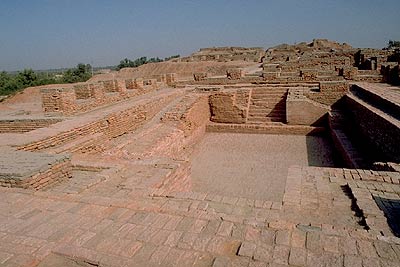
|
|
|
| |
|
"Granary," Harappa
The so-called "granary" of Harappa is found on Mound F. It is a brick structure that was built on a massive brick foundation over 45 meters north south and 45 meters east-west. Two rows of six rooms that appear to be foundations are arranged along a central passageway that is about 7 meters wide and partly paved with baked bricks. Each room measures 15.2 by 6.1 meters and has three sleeper walls with air space between them. A wooden superstructure supported in some places by large columns would have been built on top of the brick foundations, with stairs leading up from the central passage area. Small triangular opening may have served as air ducts to allow the flow of fresh air beneath the hollow floors.
No special concentrations of burned grain or storage containers were discovered by the earlier excavators and the interpretation of these structures as granaries is based on comparisons with Roman buildings and has no parallels with any building tradition in South Asia. Most scholars agree that there is little evidence for the construction of massive granaries at either Mohenjo-daro or Harappa and that these structures should only be seen as evidence for large public buildings. Rulers and state officials probably did meet in such large public buildings and many of them may have been used for specific religious functions, but their specific function will always remain a mystery.

|
|
|
| |
|
Great Bath and Granary
The Great Bath is situated along a north-south street with a drain covered with limestone blocks. In the background is the so-called Granary, while in the foreground are the walls of several domestic structures.
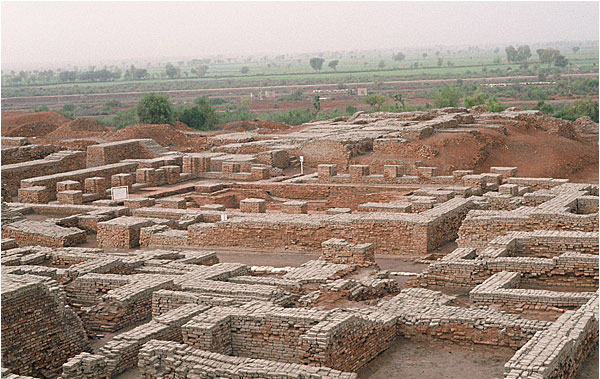
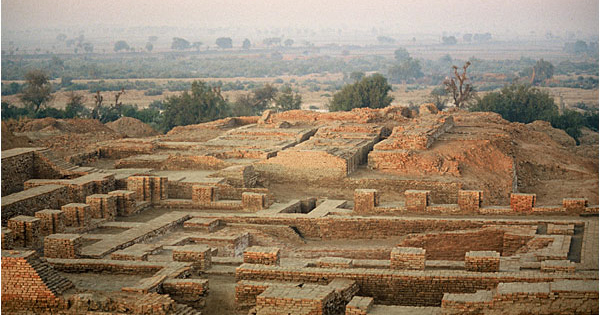
|
|
|
| |
|
A view of the houses and streets
A view of the houses and streets, with the citadel and stupa mound in the background. The tops of eroding buildings have been capped with a protective layer of mud brick that will help to soak up the efflorescent salts and protect the underlying fired brick from fragmentation.
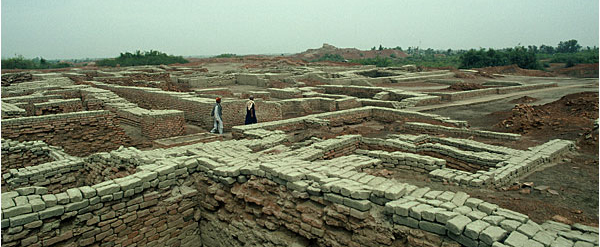
|
|
|
| |
|
Working Platforms, Harappa
To the south of the "granary" or "great hall" at Harappa is an area with numerous circular working platforms that were built inside small rooms or courtyards. These circular working platforms may have been used for husking grain. One of these circular platforms had what may have been a large wooden mortar placed in the center.
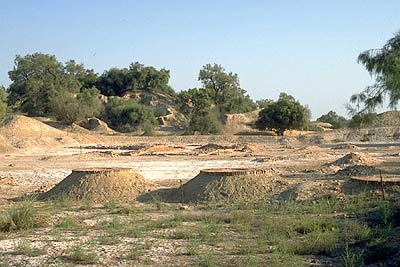
Circular platforms (below) in the southwestern part of Mound F excavated by M.S. Vats in the 1920s and 1930s, as conserved by the Department of Archaeology and Museums, Government of Pakistan.
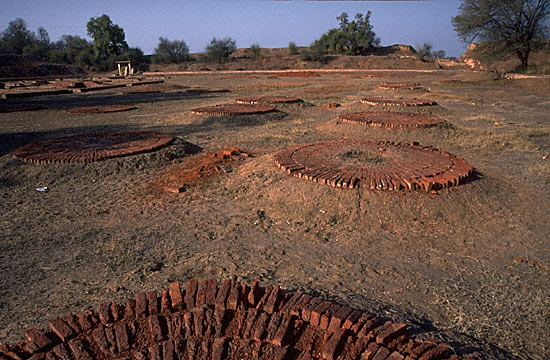
|
|
|
|
| |
|
Housing Project, Harappa
The circular working platforms are in the background and a row of identical houses that were clearly made all at one time, possibly a housing project of some wealthy merchant or perhaps sponsored by the city council.

|
|
|
| |
|
Mohenjo Daro Well
Private wells were rebuilt over many generations to serve the needs of a large household or neighborhood. This well at Mohenjo-daro stands like a chimney because all of the surrounding earth has been removed by excavation.

|
|
Private Well
Each block of buildings at Mohenjo-Daro was supplied with one or more wells. When archaeologists excavated the fill around the well they were left standing to show the final levels of use.
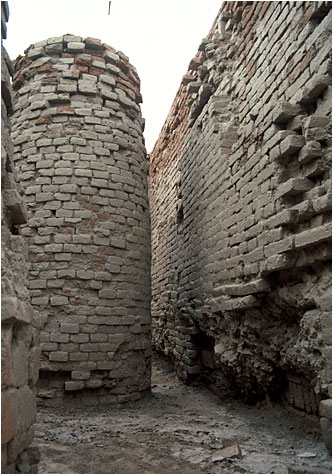
|
|
|
|
| |
|
Well and Platform
This well was associated with a finely constructed bathing platform. A stairway leads up to the well and platform from a lower room. The walls and well have been covered with mud brick and sprayed with clay slurry to protect them from salt crystallization.
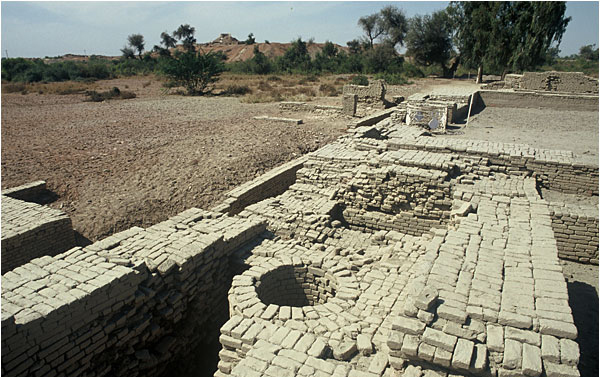
|
|
|
| |
|
Public Well Harappa
A large public well and public bathing platforms were also found at Harappa. These public bathing areas may also have been used for washing clothes as is common in many traditional cities in Pakistan and India today.
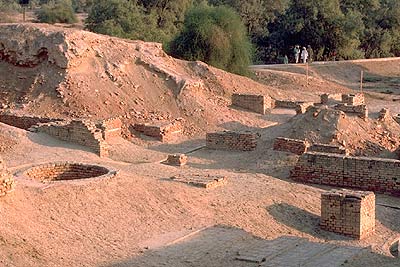
|
|
|
| |
|
Public well
Although most wells were located inside private buildings, the city planners of Mohenjo Daro provided some public wells that could be accessed directly from the main street. This well and nearby walls have been covered with mud brick to protect them from salt crystallization.
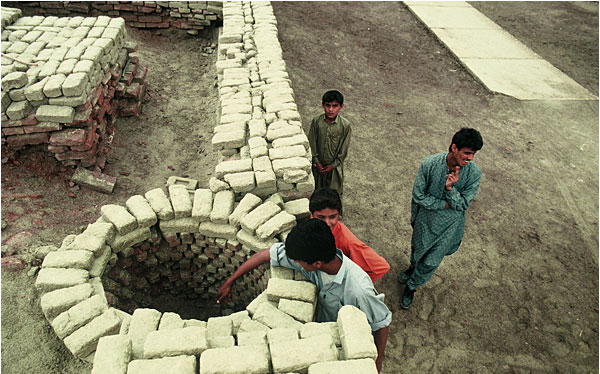
|
|
|
| |
|
Large Well
Wells were made with wedge shaped bricks to make a strong circular structure. Some bricks were made with special grooves to keep the ropes from sliding sideways when drawing water.

|
|
|
| |
|
Well surrounded by paving
This well was originally surrounded by a paving that has recently been reconstructed.

|
|
|
| |
|
Oval Well
This oval well is located to the northeast of Great Bath. It is the only well with an oval structure and may have been used to draw water for nearby bathing platforms or for filling the Great Bath.
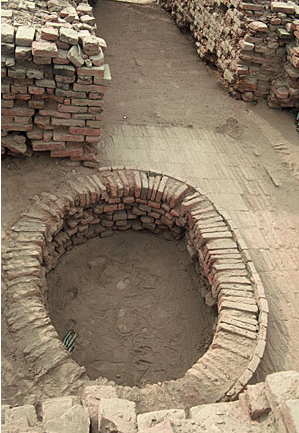
|
|
|
| |
|
Pipal-leaf shaped well
This unique well and associated bathing platform was discovered in the course of building a catchment drain around the site. It was reconstructed on the ground floor of Mohenjo-daro site museum.
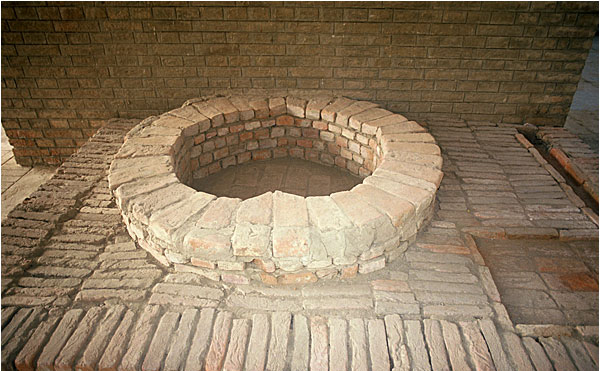
|
|
|
| |
|
Mohenjo Daro Bath
Almost every house unit at Mohenjo-daro was equipped with a private bathing area with drains to take the dirty water out into a larger drain that emptied into a sewage drain. Many of these bathing areas had water tight floors to keep moisture from seeping into the other rooms nearby or below.
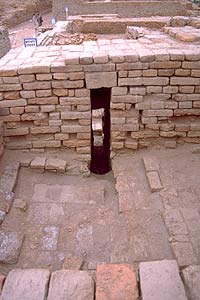
|
|
Drain outlets
Close-up view of ground floor drain outlet from the street side, showing a brick on edge with a notch was placed across the drain hole to keep objects from flowing out with the bath water.
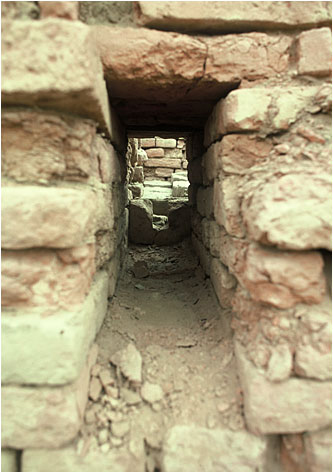
|
|
|
|
| |
|
Bathing platform
A bathing platform with brick floor made with flat paved bricks. Many bathing platforms were made with watertight floors constructed with bricks laid on their edge.
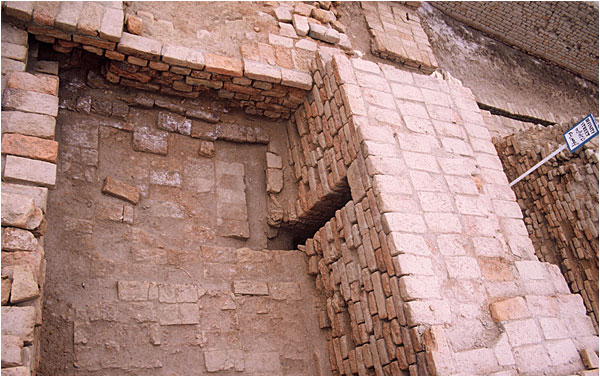
|
|
|
| |
|
Indus Valley Street with Covered Drain
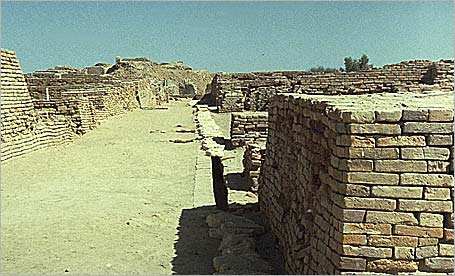
|
|
|
| |
|
Limestone drain covers
This large drain was partly covered along its length with large flat blocks made out of limestone from the Rohri hills, which are located to the north and on the other side of the Indus River.
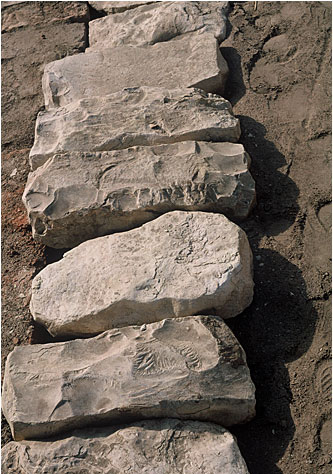
|
|
Harappa Drain
Excavated by the Harappa Archaeological Research Project in 1993, this large corbelled drain was built in the middle of an abandoned gateway at Harappa to dispose of rainwater and sewage.

|
|
|
|
| |
|
Covered Drain
Covered Drain emptying down slope on major street leading to the Great Bath.
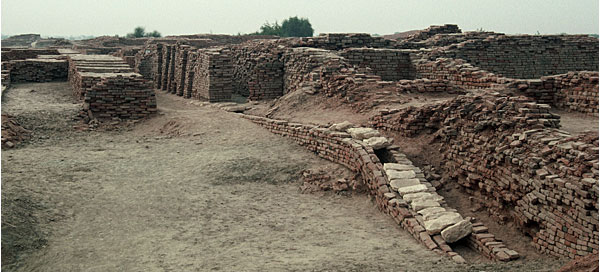
|
|
|
| |
|
Corbelled arch drain
Many large covered drains were constructed with corbelled arches. These drains ran beneath streets and lanes and were large enough for workmen to enter and clear any obstructions.
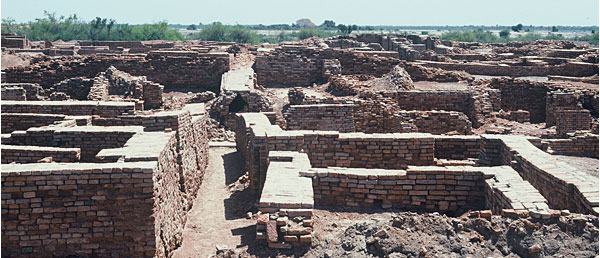
|
|
|
| |
|
Corbelled Drain exiting the Great Bath
This drain cuts through the edge of the so-called granary. If the entire drain were constructed along with the Great Bath, this feature would indicate that the original "granary" was built before the great bath.
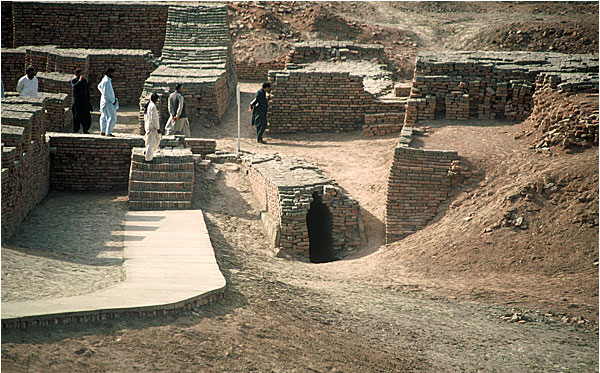
|
|
|
| |
|
Looking out from inside the drain
The corbelled arch drain from the great bath is large enough to walk into. It has a small ledge on either side of the actual drain channel.
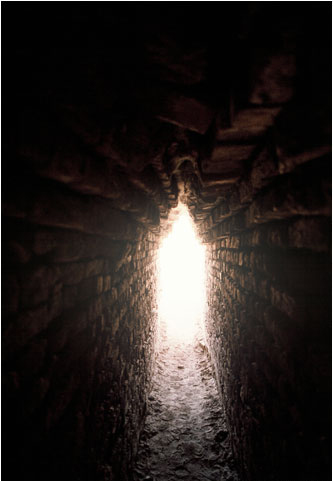
|
|
Blocked Corbelled Drain
As structures were filled and street levels were raised, the drains eventually became useless and were blocked with debris and brick walls.
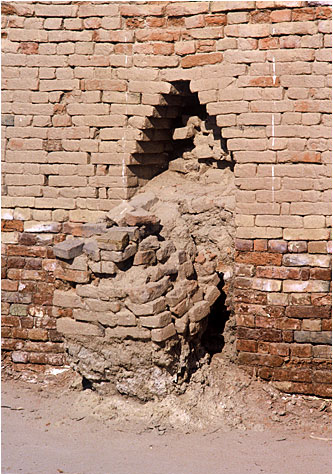
|
|
|
|
| |
|
Toilet
Toilets would have been an essential feature in Mohenjo-daro, but the early excavators identified most toilets as post-cremation burial urns or sump pots. This brick structure had a hole in the top that was connected to a small drain leading out of the base into a rectangular basin (not reconstructed). Early excavators suggested this might have been a toilet.
Two structure with a hole and drain located are thought to have been toilets. While these two structures may have been unique examples of toilets, most people would have used old pots set into the ground as commodes.
 
|
|
|
| |
|
College Building Courtyard
A large open space or courtyard (10 meters square) is surrounded by a wall that had 13 openings, possibly for windows. This unique structure is situated in the northern part of an extremely large building complex containing around 78 rooms and passageways, but no well. The building lies to the east of the Great Bath and was thought to be a "college" or residence of priests.
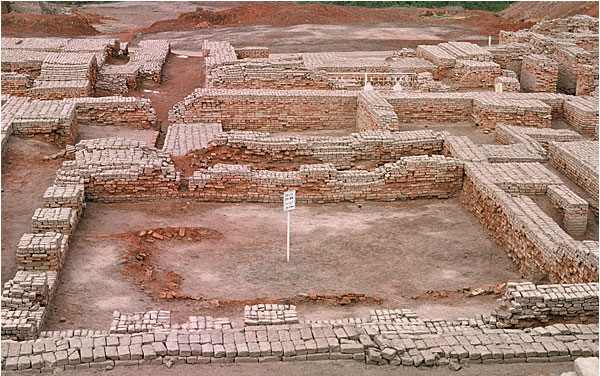
|
|
|
| |
|
Dyer's Workshop
This room was made with bricks set on edge to create a watertight floor. A small well was located in the southeast corner (top right) and circular brick depressions were set into the floor, presumably to hold pottery vessels. The early excavators suggested that the room might have been a dyer's workshop.
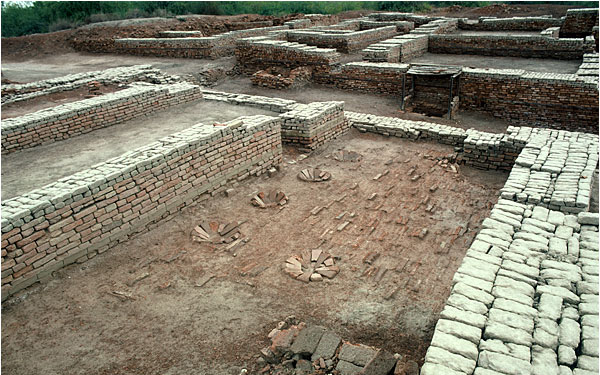
|
|
|
| |
|
Looking down inside two rooms
This view into two small rooms shows tapered walls that were built to support a second floor. Later rooms were built directly on top of these walls because they provided a strong foundation. The wall of the building across the street shows multiple phases of rebuilding

|
|
Narrow Lane
Oxcarts could not reach many of the urban neighborhoods. Pack animals and pedestrians could have used this narrow lane.
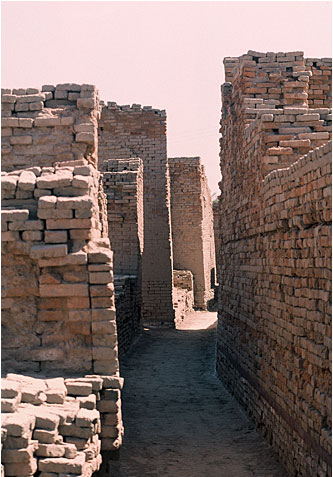
|
|
|
|
| |
|
Narrow streets and drains
The streets and alleyways wind through the neighborhood and are oriented along a strict grid plan.
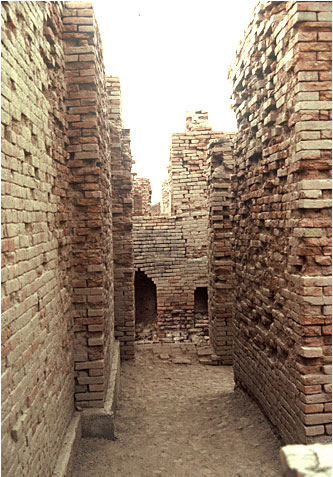
|
|
Narrow streets
The doors of later buildings can be seen in the upper levels of the wall to the left. The gradual tapering of the walls in the far right was an intentional architectural feature to avoid collapse of the upper floors.
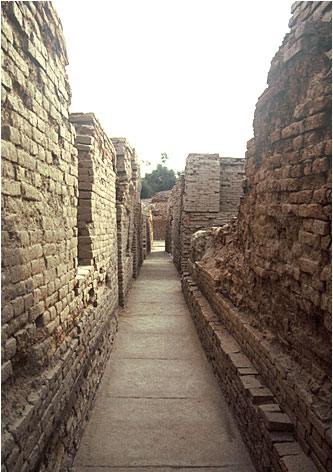
|
|
|
|
| |
|
Traffic control block and Street
Looking south along the street to the east of the Great Bath. In the foreground is a unique brick platform with hollow sockets used to place upright beams that may have formed a gate or traffic control device. A large street drain covered with limestone blocks runs the length of the street.
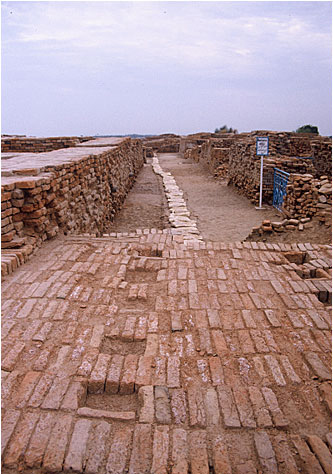
|
|
|
| |
|
First Street
Looking north along First Street. The area to the left has been fully excavated and the area to the right is unexcavated. Later street levels are seen in the background.

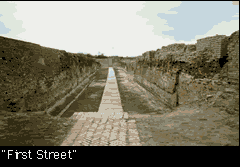
|
|
|
| |
|
Stairs leading to the second storey
Some houses had small staircases leading to a second story or to a platform for pouring water into a bathing area.

|
|
|
| |
|
Modern house with well and drains, Sehwan
The old part of the city of Sehwan, Sindh, is built on a high mound of the earlier buried city, much like ancient Mohenjo-daro. A neighborhood well is located alongside the street that has an open drain. A private courtyard is shaded by a date palm. Small drains from the houses on either side of the street lead to the main street drain.
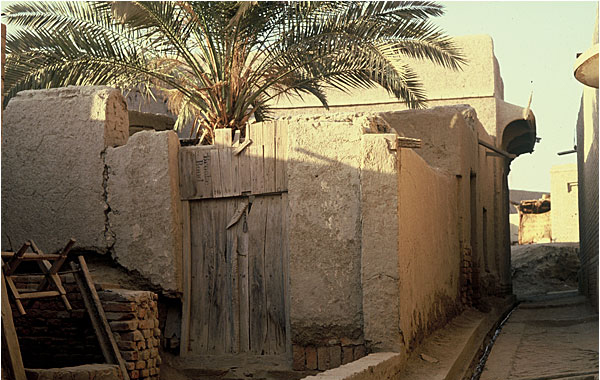
|
|
|
| |
|
| |
|
| |
|
| |
|
| |
|
| |
|